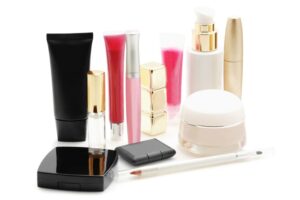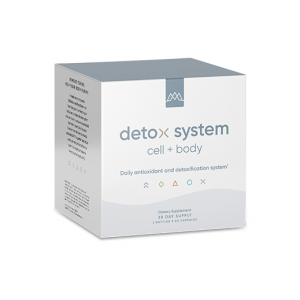Does Your Skin Need a Detox?
 Consider how many personal products you use daily. Products such as shampoo, conditioner, toothpaste, soap, deodorant, lip balm, sunscreen, body lotion, shaving products, and makeup most likely include more toxins than you can imagine.
Consider how many personal products you use daily. Products such as shampoo, conditioner, toothpaste, soap, deodorant, lip balm, sunscreen, body lotion, shaving products, and makeup most likely include more toxins than you can imagine.
An Environmental Working Group (EWG) survey found people use an average of 9 different personal care products every day, with 25% of women and one percent of men using 15 or more. Altogether, these products contain some 126 unique ingredients, and we use some (such as lipstick) several times daily.
Unfortunately, many of these products contain potentially toxic ingredients that your skin absorbs.
“Personal care products are manufactured with 10,500 unique chemical ingredients, some of which are known or suspected carcinogens, toxic to the reproductive system or known to disrupt the endocrine system,” says the EWG. [1]
In his book Toxic Beauty, Samuel S. Epstein, MD, says of the 3,000 mostly synthetic chemicals used in fragrances alone, at least 900 identify as having some degree of toxicity by the National Institute of Occupational Safety and Health. [2]
Those types of statistics become especially troubling when you consider a 2009 report that found the average woman puts 515 synthetic chemicals on her body every day. Furthermore, the Organic Consumers Association says that women who use makeup daily can absorb almost 5 pounds of chemicals into their bodies each year. [3] [4]
Your skin is your body’s largest organ and the first protection against many toxic encounters. Among its duties, your skin filters out what should be absorbed and eliminated.
5 Common Toxic Ingredients to Avoid
Researchers at the Centers for Disease Control and Prevention (CDC) find that many people absorb these toxic ingredients in their skin. So, which ingredients are toxic? Here’s a list of a few common ones:
1. Phthalates
In her book Younger, Sara Gottfried, MD, says these can be linked to breast cancer and Type 2 diabetes as well as birth defects in male fetuses and early menopause in women. This toxic ingredient is commonly found in nail polishes, hair sprays, aftershave lotions, soaps, shampoos, and fragrances. [5]
2. Parabens
The CDC found widespread exposure to parabens, although they argue measurable amounts don’t imply parabens cause adverse health effects. [6] According to the European Scientific Committee on Consumer Safety, the main concern with parabens in cosmetics is the potential of some to act like hormones (especially estrogens). [7] This toxic ingredient is commonly found in makeup, moisturizers, hair care products, and shaving products. [8]
3. Sodium lauryl sulfate (SLS)
SLS creates foaming or lather in products. “The suds are nice, but not worth the skin irritation, hair loss, and risk of breast cancer and male infertility that come with it,” says Gottfried. The EWG classifies SLS as an environmental toxin with strong evidence that it can irritate the skin. This toxic ingredient is commonly found in makeup, toothpaste, hair care products, and beauty creams, among other products. [9]
4. Triphenyl phosphate (TPhP)
TPhP makes nail polish resist chipping. (Gottfried notes it’s also a fire retardant in furniture.) One animal study found TPhP disrupts carbohydrate metabolism, lipid metabolism, and DNA damage repair. [10] This toxic ingredient is commonly found in nail polish and nail treatments. [11]
5. Titanium dioxide
According to the California Safe Cosmetics Program (CSCP), titanium dioxide was listed as a potential human carcinogen. They say over 80% of all products reported contain titanium dioxide. [12] This toxic ingredient is commonly found in makeup, sunscreens, soaps, and beauty creams, among other products. [13]
7 Ways to Minimize Toxic Beauty Products
 While potentially damaging ingredients among beauty products can feel incredibly alarming, there’s some hope regarding cosmetics. Consumers are demanding change, and researchers believe the FDA’s outdated regulations might become revised.
While potentially damaging ingredients among beauty products can feel incredibly alarming, there’s some hope regarding cosmetics. Consumers are demanding change, and researchers believe the FDA’s outdated regulations might become revised.
Some companies are stepping in to address these concerns. Among them are Whole Foods, who restricts 50 ingredients in any personal care product they sell. Likewise, Wal-Mart aims to eliminate eight chemicals (including parabens and formaldehyde) in 90,000 products it stocks. [14]
However, researchers argue we need federal legislation, not grocery stores, to call the shots. The FDA needs more authority and resources to regulate cosmetics and personal care products.
Moreover, you can’t totally depend on stores, manufacturers, or government to effectively regulate cosmetics. As consumers, we must become more proactive. Here are some effective ways to avoid toxic beauty products and avoid potentially toxic skincare products:
1. Go organic
Certified organic cosmetics make a less-toxic alternative to conventional cosmetics with skincare ingredients to avoid. Look for products labeled USDA Certified Organic — visit here to learn the USDA’s approved brands. [15] [16] They may be more expensive, but treat cosmetics as you would food products — you would pay more for organic produce, so why not organic cosmetics?
2. Beware of empty marketing terms
Some products boast meaningless terms including “gentle,” “pure,” and “natural” that says nothing about the safety of that product’s ingredients. American sales of “natural” personal care products grew about 7.5% in 2014, but we have no legal definitions for such terms. [17]
3. Do it yourself
You’ll find a wealth of online recipes for moisturizers, deodorants, and so much more online that are far less toxic than store-bought personal care products. Making them will save you money and may save your health. Extra-virgin organic coconut oil, for instance, makes a very versatile product for skin, teeth, and more. Researchers found this oil is incredibly well absorbed, moisturizes skin, and benefits a number of skin conditions including atopic dermatitis. [18]
4. Scrutinize ingredients closely
Remember that ingredients are listed in decreasing order, so that product will contain more of the first few ingredients. An excellent resource to check specific products is the EWG’s Skin Deep® guide, which provides a wealth of information about popular cosmetics and allows you to check almost 75,000 products. [19]
5. Know that some toxic ingredients aren’t listed
Skincare ingredients to avoid aren’t allows listed. An example of this is lead, which Gottfried says is a neurotoxin in lipstick and in dark hair dyes that may damage your cognitive ability. In one study, researchers found this highly toxic metal in cosmetic samples. [20] Pay attention to more than just what the ingredients say. Look into the brand’s integrity to avoid toxic beauty products.
6. Demand better
While researchers look for answers, the landscape of personal care products won’t change unless consumers demand it. Manufacturers and makers can only develop what people want to buy, and until that looks like more natural, safer products, we’ll only see more of the same. [21]
7. Ask yourself these 2 questions
“Drugs and chemicals are well absorbed through your skin,” says Mark Hyman, MD, in The Blood Sugar Solution. “If you wouldn’t eat it, don’t put it on your skin.” Can you eat it? Can you pronounce it? With a very few exceptions, if you answer no to both questions, put that product back.
Avoiding toxic ingredients in cosmetics requires reading labels, choosing ethical brands, and becoming proactive about what beauty products you put on your skin. Homemade is best since you know exactly what goes into that product. Second best is organic products from companies you trust.
Most importantly, reducing toxin exposure and all its potential repercussions ultimately go beyond cosmetics. What you eat and how you live can significantly impact your body’s toxic burden. Check out our Healthy Articles archive to learn more about how you can become a strong advocate for the most important thing in your life: your health.
 Considering detoxing?
Considering detoxing?
Try our scientifically-based Detox System with the guidance of a qualified practitioner if you want to detox from toxins in your life.
References
http://www.ewg.org/skindeep/2011/04/12/why-this-matters/#.WuSJgS_MwWo
https://www.amazon.com/s/ref=rdr_kindle_ext_aut?_encoding=UTF8&index=books&field-author=Samuel%20S.%20Epstein&search-alias=digital-text
https://www.dailymail.co.uk/femail/beauty/article-1229275/Revealed–515-chemicals-women-bodies-day.html
https://www.telegraph.co.uk/news/uknews/1555173/Body-absorbs-5lb-of-make-up-chemicals-a-year.html
https://www.cdc.gov/niosh/topics/skin/
https://www.cdc.gov/biomonitoring/Parabens_FactSheet.html
https://ec.europa.eu/health/scientific_committees/docs/citizens_parabens_en.pdf
https://www.fda.gov/cosmetics/productsingredients/ingredients/ucm128042.htm
https://www.ewg.org/skindeep/ingredients/706110-SODIUM_LAURYL_SULFATE/
https://www.ncbi.nlm.nih.gov/pubmed/26898711
https://www.ewg.org/skindeep/ingredient/706709/TRIPHENYL_PHOSPHATE/#.WvWvfIgvyUl
https://www.cdph.ca.gov/Programs/CCDPHP/DEODC/OHB/CSCP/CDPH%20Document%20Library/DataReport.pdf
https://www.ewg.org/skindeep/ingredient/706561/TITANIUM_DIOXIDE/#.WvWv3YgvyUk
https://www.nbcnews.com/business/consumer/wal-mart-eliminate-controversial-chemicals-90-000-products-n614181
https://www.ams.usda.gov/grades-standards/cosmetics-body-care-and-personal-care-products
https://www.loveandlavender.com/2019/08/best-organic-makeup-brands/
https://www.ncbi.nlm.nih.gov/pmc/articles/PMC4421754/
https://www.ncbi.nlm.nih.gov/pmc/articles/PMC5796020/
https://www.ewg.org/skindeep/#.WuXv2C_MwWp
https://www.ncbi.nlm.nih.gov/pubmed/26296330
https://www.ewg.org/news-and-analysis/2018/01/natural-or-organic-cosmetics-don-t-trust-marketing-claims


